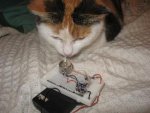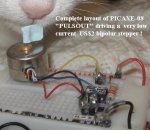Those with an eye to bargains may know US firm Electronic Goldmine offer an appealingly small 5 wire 5 Volt stepper at attractive prices => http://www.goldmine-elec-products.com/prodinfo.asp?number=G14197.
These have appeared with good feedback in diverse Instructables => http://www.instructables.com/id/Drive-a-Stepper-Motor-with-an-AVR-Microprocessor/?ALLSTEPS & also ProfMason's increasingly Picaxe orientated site => http://profmason.com/?m=200612, so I grabbed a bunch at ~US$2 to suit student projects. Yes- $2 !Perhaps I was robbed, as they were earlier selling at US 99 cents ! I've only just given them a look see to find they're essentially just a 4 wire bipolar,rather than a CT unipolar, BUT with a current demands so low (~20-50mA) that direct PICAXE connection looked feasible. Naturally at least an NPN (BC547 etc) would normally be used as a current booster when driving from a PICAXE, much as shown P.238 in David Lincoln's PICAXE book.
Numerous steppers flood the market, many ex printers & floppy drives & free to a good home etc, but these are usually pretty power hungry (often 12V at ~a few Amps),& require MOSFETs & specialised motor driver ICs. Argh- the next thing you know grunty PSUs, parts $$($), rats nest layouts & much running around has occurred, all serving to daunt those keen to experience a few stepper basics. Typically this means schools where " £1 a head" project budgets prevail, & a single technician that has to service 1000 students spread over a dozen labs... Count yourself lucky the rest of you.
Hence it's with some "smell of a oily rag" satisfaction that I can report an ultra barebones setup worked a treat, with easy coil pair sequencing via timed PULSOUTs that even a baby 08 can produce. Initial trials of a clockwise & C-CW washing machine agitator action were voted most entrancing by an impressionable feline audience! An overnight soak test has so far revealed no ill effects - total current drain from the 3 x AA (4½V) supply was ~ a meagre 20mA (which naturally includes 3-5mA for the PICAXE as well). YMMV
Aside from some soldered header pins & hot melt glue reinforcement to the stepper leads, absolutely no other parts were needed at all! See => www.picaxe.orcon.net.nz/stepdemo.jpg with code => www.picaxe.orcon.net.nz/stepdemo.bas Stan
These have appeared with good feedback in diverse Instructables => http://www.instructables.com/id/Drive-a-Stepper-Motor-with-an-AVR-Microprocessor/?ALLSTEPS & also ProfMason's increasingly Picaxe orientated site => http://profmason.com/?m=200612, so I grabbed a bunch at ~US$2 to suit student projects. Yes- $2 !Perhaps I was robbed, as they were earlier selling at US 99 cents ! I've only just given them a look see to find they're essentially just a 4 wire bipolar,rather than a CT unipolar, BUT with a current demands so low (~20-50mA) that direct PICAXE connection looked feasible. Naturally at least an NPN (BC547 etc) would normally be used as a current booster when driving from a PICAXE, much as shown P.238 in David Lincoln's PICAXE book.
Numerous steppers flood the market, many ex printers & floppy drives & free to a good home etc, but these are usually pretty power hungry (often 12V at ~a few Amps),& require MOSFETs & specialised motor driver ICs. Argh- the next thing you know grunty PSUs, parts $$($), rats nest layouts & much running around has occurred, all serving to daunt those keen to experience a few stepper basics. Typically this means schools where " £1 a head" project budgets prevail, & a single technician that has to service 1000 students spread over a dozen labs... Count yourself lucky the rest of you.
Hence it's with some "smell of a oily rag" satisfaction that I can report an ultra barebones setup worked a treat, with easy coil pair sequencing via timed PULSOUTs that even a baby 08 can produce. Initial trials of a clockwise & C-CW washing machine agitator action were voted most entrancing by an impressionable feline audience! An overnight soak test has so far revealed no ill effects - total current drain from the 3 x AA (4½V) supply was ~ a meagre 20mA (which naturally includes 3-5mA for the PICAXE as well). YMMV
Aside from some soldered header pins & hot melt glue reinforcement to the stepper leads, absolutely no other parts were needed at all! See => www.picaxe.orcon.net.nz/stepdemo.jpg with code => www.picaxe.orcon.net.nz/stepdemo.bas Stan
Attachments
-
30.6 KB Views: 385
-
39.9 KB Views: 366
Last edited:


